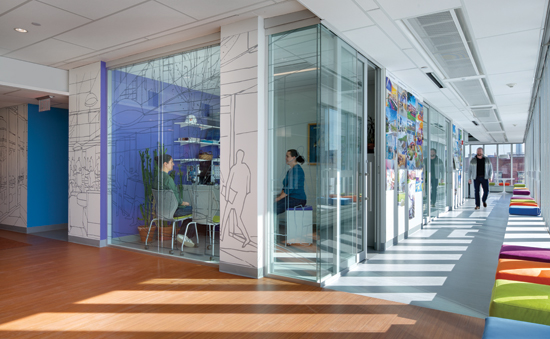Active Chilled Beams Come of Age
Learning Objectives:
- Compare the energy efficiency of a traditional heating ventilating air conditioning system to a chilled beam system.
- Discuss the design considerations of an active chilled beam in promoting an energy efficient, aesthetic, cost-effective solution that meets green building goals and the safety and well being of building users.
- Explain the issue of condensation and how it can be controlled for optimum functioning of an active chilled beam in the context of a sustainable application that supports indoor air quality.
- Specify a chilled beam application that is appropriate for a particular building type in order to increase energy efficiency and enhance occupant comfort.
Credits:
Building energy efficiency, sustainability, and interior aesthetics are concepts that may often appear to be at odds. Yet designers must balance these concepts within budget restrictions and energy code requirements—a feat, say industry experts, that will be increasingly hard to achieve. The “Annual Energy Outlook 2014” published by the U.S. Energy Information Administration (EIA) estimates that between 2012 and 2040, commercial building energy consumption will grow by 0.6 percent annually, while the growth of commercial floor space averages 1.0 percent per year and the energy intensity, or energy use per square foot, will decrease by 0.4 percent per year. This decrease is expected to come from federally mandated gains in equipment efficiency and reduced consumption by space heating, cooling, lighting, and plug loads. The key takeaway here is that, again, over time, it will become increasingly difficult to balance the energy code requirement, budget restrictions, and interior aesthetics.
How then can design goals be met while reducing energy?
Traditionally, most buildings have used air movement to transfer both the fresh air and thermal energy needed to properly heat, cool, and ventilate occupied spaces. Air, however, is not a very energy-dense media, and significantly more air is often required to cool a space than to provide fresh air.
The requirement for high volumes of air to condition the building and the inherent inefficiency in moving air around the building have presented considerable challenges in using the traditional all-air HVAC design approach to meet increasingly restrictive energy codes. As a result, industry experts are exploring alternative methods. Water, for example, is often considered as the transport media of choice for energy-efficient thermal energy transfer. Water can store significantly more thermal energy per unit volume than the same volume of air, and because it has a higher energy density and a higher pumping efficiency, water requires less transport energy—by pump rather than by fan—to move thermal energy into and out of the occupied spaces. When used as the sole media to provide building heat and cooling needs, water has a lower operational cost than an equivalent all-air system. Of course, a certain amount of air movement is required for the proper ventilation of the occupied space. However, an air-water HVAC system that provides only ventilation-required air volumes can lead to an estimated reduction in building mechanical system power of 15 to 40 percent or more in some situations, depending on the overall system design.

HMFH Architects, Inc. Corporate Office. Photo © Ed Wonsek.
Active chilled beams have energy-saving potential in all building types.










